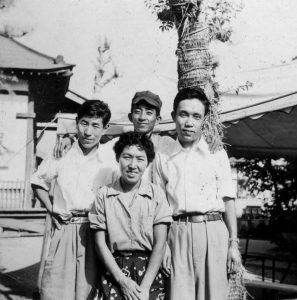My Life — Interview with Hiromu Morishita (1930–), A-bomb survivor and teacher, Part 8: Emotional conflict
Apr. 29, 2022
Days of suffering with facial scars
Hiromu Morishita met the late Ichiro Kawamoto around the time he was about to start teaching.
Ichiro Kawamoto is known for having pushed for establishment of the Children’s Peace Monument. At the time, he was working with Kiyoshi and Ikimi Kikkawa (both now deceased), who operated a souvenir shop near the Atomic Bomb Dome (located in Hiroshima’s Naka Ward). They formed an A-bomb survivors’ group in the early days. I met them by chance when I took an old friend of mine who was visiting from a different prefecture to the A-bomb Dome.
Mr. Kawamoto was distributing money and relief supplies collected from all over Japan to needy A-bomb survivors. I probably drew inspiration from him and his efforts. I helped make mimeographed newsletters and did other things as they instructed me to do. Looking back, I think that might have been my first involvement in peace activities.
He also felt conflicted. In 1956, the Atoms for Peace Exhibit was held at the Hiroshima Peace Memorial Museum, located in the city’s Naka Ward. When visiting the museum at the time with his students, he received a shock.
That was probably the first time that I had visited the Hiroshima Peace Memorial Museum. The visit left me depressed, because I heard my students say in front of photos of victims with keloid scars, “Scary” and “I won’t be able to sleep tonight.”
My father used to encourage me by saying it wasn’t looks that counted, but one’s frame of mind. And I thought I had been able to accept things as they were. I had also come to believe that it wasn’t my fault my face looked like this. However, anxiety and an inferiority complex again haunted me. I began to wonder whether showing my keloid scars to students depressed them and resigned myself to thinking that “what’s ugly is ugly.” I could no longer face my students and stopped talking about the atomic bombing.
However, I joined the Hiroshima Prefecture Mobilized Student Victims Association, an organization that was founded in 1957. Seeking compensation from Japan’s government as a victim of the atomic bombing, I visited the then-Ministry of Health and Welfare to petition them for help. The transportation at the time was steam locomotive, so it took a long time to get to Tokyo. My petition for redress was rejected many times. It seems to me now that petitions submitted by women were granted relatively quickly. My disability pension finally began to be paid to me in 1969, more than 10 years after my first petition.
He started working at Hiroshima Prefectural Otake High School in 1957 and, in 1960, was transferred to Hiroshima Prefectural Hatsukaichi High School, where he worked for 30 years.
Soon after being transferred to Hatsukaichi High School, I overcame my doubts and began to devote myself to peace education. One of the main reasons for that was the birth of my first daughter.
(Originally published on April 29, 2022)








